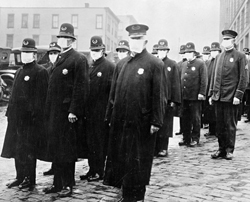People have crazy ideas about how they will die. They fear earthquakes and floods, murderous attackers and terrorists. They worry about car crashes and airplane crashes, shark attacks and snake bites. Lately, the big fear centers on the return of pandemic influenza. I personally have an unreasonable fear of falling over the side of a cliff.
These dangers are all possible ways to die, of course, but their likelihood is incredibly small. And while theoretically many of these dangers could be averted — by steering clear of earthquake- and flood-prone areas, eschewing cars and planes, staying out of the water, practicing social isolation during flu season — it’s no way to live a full life. These are all, in sum, largely rare and uncontrollable fates.
Consider the facts on what is far more likely to kill us, according to “The Global Burden of Disease and Injury Series,” a massive compendium of the things that endanger our health from researchers at the World Health Organization and the Harvard School of Public Health:
• By 2020, heart disease and stroke will become the leading cause of both death and disability worldwide.
• Global cancer rates could increase by 50 percent to 15 million new cases by 2020. Researchers say cancer already kills more people worldwide than AIDS, tuberculosis, and malaria combined.
• By 2020, tobacco — a major risk factor for lung diseases, various cancers, and cardiovascular disease — is expected to kill more people than any single disease, surpassing even the HIV epidemic.
• Deaths from noncommunicable diseases — particularly heart disease, cancer, and diabetes — would increase by 77 percent worldwide, due mostly to the aging of the population.
Basically, this report finds that we are probably going to die from a chronic disease, possibly one that we could have prevented by following the basic tenets of a healthy life: eating a moderate diet, exercising regularly, not drinking too much, not smoking, and not taking illicit drugs. That is, many of the things that are likely to kill us are also, at least partially, controllable. A report on the leading causes of U.S. death in 2000 proves it, listing tobacco use, poor diet and physical inactivity, and alcohol consumption as the top three killers. A prior report on the leading causes in 1990 also found the same thing.
So why don’t we stop worrying about death by disaster or high drama and take some control of our fate by living more healthfully? Perhaps because this would require prioritizing our future self over who we are today. It is one thing to know what is good for us, and it is quite another to live preventively every day, abstaining from many of life’s pleasures along the way. Furthermore, living healthfully is no guarantee of freedom from disease.
Or perhaps it is because we don’t actually believe in the inevitability of our own death. Just as the first few gray hairs or wrinkles are a surprise — even though we knew they would come eventually — the arrival of death, be it fast or slow, will likely surprise us, too. Both Freud and Schopenhauer noted that on a deep, personal level, people do not really believe in their own death, and Heidegger noted that the concept that all men are mortal usually involves a tacit reservation “but not I.”
This “but not I” syndrome may be an essential element of survival. It allows us to get on with the activities of daily life without over-worrying about our future demise. That is probably a good thing most of the time.
Still, it’s likely to be hard, once the heart disease, the cancer, or the diabetes does make its unwelcome arrival — and it inevitably will for most people — not to wonder if a healthier life might have prevented it. Maybe people are starting to pick up on this fear, at least subconsciously. The WHO found that depression is a growing cause of disability worldwide. Already the fourth leading cause of premature death and disability, some policymakers predict that it could surpass even cardiovascular disease and reach #1 by 2020. • 4 December 2007
SOURCES: Estimating the Contributions of Lifestyle-Related Factors to Preventable Death: A Workshop Summary. Planning Committee on Estimating the Contributions of Lifestyle-Related Factors to Preventable Death. The National Academies Press (Washington, DC, 2005). The Dictionary of the History of Ideas: Studies of Selected Pivotal Ideas, edited by Philip P. Wiener, published by Charles Scribner’s Sons (New York, 1973-74). Global Burden of Disease: A comprehensive assessment of mortality and disability from diseases, injuries, and risk factors in 1990 and projected to 2020. Editors Christopher J.L. Murray and Alan D. Lopez. Harvard University Press. (Cambridge, 1996). “Actual causes of death in the United States, 2000,” Mokdad AH, Marks JS, Stroup DF, & Gerberding JL. JAMA. 2004;291:1238-45.




